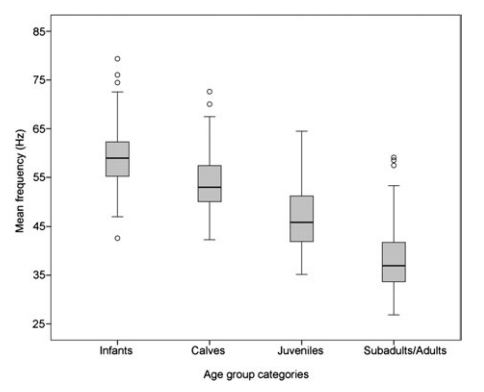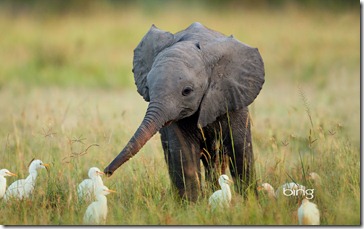In Dr. Seuss’s book, Horton Hears A Who!, Horton finds a speck of dust containing a microscopic town called Whoville. While Horton is able to hear the townspeople, he is criticized by other animals for believing in something they cannot see or hear. In response, the town of Whoville makes the loudest noises they can in order to establish their presence and identity. Similarly, elephant vocalizations may encode information about their identity–sex, kinship, and even age. Recently, research on elephant vocal signals has shown it is possible to estimate the age groups of African elephants based on acoustic parameters extracted from their rumbles. In other words, we may be able to hear who Horton is.
Elephants produce powerful sounds with frequencies in the infrasonic range (below 20 Hz). Infrasonic sounds are not detectable by human ears, since they are below 20 Hz. Unbeknownst to humans, these sounds are able to travel up to several kilometers. Acoustic monitoring is typically used to estimate elephant abundance, even in dense forests. In the open, elephants can be detected visually, but in the forest, sound really helps in our estimation of elephant abundance. Recently, Stoeger et al. (2014) show that it is possible to discriminate age groups based on acoustic parameters extracted from elephant rumbles.
Since there is a direct relationship between body mass, vocal fold size, and fundamental frequency (lowest frequency made in the sound), Stoeger et al. (2014) hypothesize that we can use the frequency harmonics of elephant rumbles to discriminate between infants, calves, juveniles, and adults. Since infant elephants have a much smaller body size, they are less likely to produce low frequency sounds. While adults are much larger and can produce infrasonic rumbles.
To test their hypothesis, Stoeger et al. (2014) recorded elephants at the Addo Elephant National Park in South Africa using both sound and video. Recordings were conducted at distance of 10 to 60 meters away from the elephant, and the researchers paired the physical mechanisms of the vocalization (open mouth, lifted or spread ears, general body postures or changes in posture, etc.) from the video recording with the sound recordings. For data analysis, Stoeger et al. (2014) created a classification system that determines the elephant’s age. The system incorporates data from the recordings and separates components such as frequency, harmonics, and subharmonics.

Box-plot showing the decrease in frequency with age of elephant rumbles (based on the second harmonic). Click image for source.
The classification system created by Stoeger et al. (2014) was able to discriminate adults from infants and calves with 95% correct classification. However, they did collapse the group of infants and calves, which possibly suggests that their classification system may not be able to determine more specific age ranges, only adult and juveniles. There was considerable overlap between adjacent groups such as infants and calves or juveniles and adults. Stoeger et al. (2014) do not find this overlap unexpected, since elephant rumbles vary with context and situations.
In a previous study by Stoeger et al. (2012), they found that African elephants can vary their formant structures (bands of frequency) by switching between nasal or oral sound production. Additionally, rumbles may vary significantly with arousal and context with a potential effect of social rank, further complicating frequency analyses of elephant vocalizations. While preliminary, this study proves that it is possible to classify the ages of elephants based on acoustic cues. This study offers a small insight into the ways animals are able to communicate and how their sounds reflect their physical components–the vocalizations of baby elephants may be more complex than you think! Furthermore, conservation efforts in maintaining elephant populations will be greatly enhanced. Now, we can know more quickly and easily where elephant populations are and the density of their populations, especially in areas where it is difficult to monitor elephants visually. Further research is necessary to refine the age classification system and the acoustic components of elephant vocalizations, but this study provides a great new approach to monitor elephant populations.
For more information, see:
Stoeger, A., Zeppelzauer, M., Baotic, A. (2014). Age-group estimation in free-ranging African elephants based on acoustic cues of low-frequency rumbles. Bioacoustics DOI: 10.1080/09524622.2014.888375
Stoeger, A.S., Heilmann, G., Zeppelzauer, M., Ganswindt, A., Hensman, S., Charlton, B.D. (2012) Visualizing Sound Emission of Elephant Vocalizations: Evidence for Two Rumble Production Type. PLoS ONE
doi: 10.1371/journal.pone.0048907


